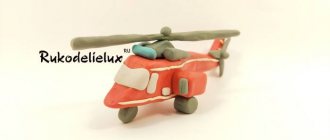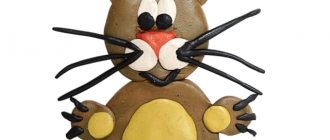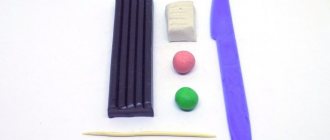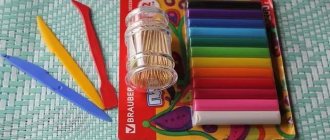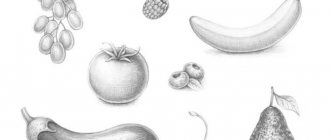Topic of the week: “Insects”
Lesson 35. Snail
(Modeling from plasticine)
Program content. Continue to teach how to roll out a column from a ball and roll it into a spiral, pull it back and round the ends. Exercise children in pronouncing the words of the song loudly and clearly. Develop fine motor skills of fingers.
Handout. Plasticine, short twigs or matches, cardboard stands cut out of green cardboard in the shape of tree leaves, modeling boards.
Progress of the lesson
Say a German folk song retold by L. Yakhtin with your children, while using the finger of one hand the kids need to draw a snail in a spiral on the palm of the other hand:
bbw crawler
Curly house,
Crawl along the path
Crawl along the palm of your hand
Crawl, don't rush,
Show me your horns.
Invite the children to make a snail. To do this, you need to make a ball out of plasticine, roll it into a long column and twist it into a spiral, leaving a small piece of the column free. This will be the snail's head. On the opposite side, pull off the tail. On the head you need to attach two short matches (horns) and plasticine eyes in the form of small balls.
We got a lot of colorful snails!
Theme of the week: “Summer is coming”
Lesson 36. Swan on the lake
(Modeling from plasticine using natural materials)
Program content. Strengthen the ability to combine natural materials and plasticine in crafts. Practice connecting parts. Learn to supplement the craft with compositional elements.
Handout. Oval cardboard, plasticine, acorns, halves of walnut shells, pine needles, modeling boards.
Progress of the lesson
Read the poem “The Water Queen” by D. Rozalieva to the children:
The white swan is swimming
She bends her neck proudly.
And it doesn't look like a bird,
And to the water queen.
Ask the children:
– Who is this poem about? (About the swan.)
-Where does the swan swim? (On the lake.)
Offer to make a swan. Half a walnut will be the body, and an acorn will be the head. A long curved neck needs to be made from a plasticine sausage, eyes, beak and wings must be sculpted.
All that remains is to decorate the lake - apply blue plasticine to an oval cardboard, attach pine needles (reeds) to it and “send the swan sailing”.
Theme of the week: “Toys”
Lesson 33. Pyramid
(Clay crafting)
Program content. Strengthen the ability to roll clay balls of different sizes and flatten them between the palms, arrange the resulting circles in a certain order. Continue learning to connect the parts by pressing them together.
Demonstration material. Pyramid of rings.
Handout. Clay, bowls of water, cardboard stands, modeling boards.
Progress of the lesson
Look at the pyramid with your children. Discuss how there are large rings at the bottom and small rings at the top. Give each child a ring to remove, and then ask them to assemble the pyramid in the right order.
Read the poem by D. Rozalieva to the children:
I'm building a pyramid
Help me, friends.
Take different rings
Place them on top of each other.
Suggest making such a pyramid out of clay: you need to separate 3-4 pieces of different sizes from the clay, roll them into balls, flatten them between your palms and place them on top of each other, starting with the largest one. The connection points should be lubricated with a small amount of water.
When the clay dries, the rings of the pyramid can be painted.
Lesson 34. Free topic
(Modeling from plasticine or clay)
Program content. Learn to sculpt an object from plasticine according to your own design. Reinforce previously learned sculpting techniques (rolling, unrolling, flattening, pressing, attaching and smearing). Develop a friendly attitude towards others.
Demonstration material. Doll.
Handout. Plasticine, clay, various additional materials, cardboard stands, boards for modeling.
Progress of the lesson
Play out the situation: the Dasha doll came to visit you, she is dressed very smartly. Describe with the children how the doll is dressed. Let the guys ask why she is so smart.
“Today is my birthday,” answer for the doll. - I invite you to visit. Come to my place to celebrate my birthday.
Invite the children to give the doll a gift. Give each child the opportunity to come up with their own idea of what they will sculpt. Prepare additional material for the children to use to decorate the craft. Give gifts to the doll.
At the end of the lesson, you can perform a round dance “Like on our name day.”
How to mold a girl from plasticine.
Children are of great interest in sculpting all kinds of figures. This is useful in itself, as it develops motor skills. During sculpting, the child’s imagination develops. It is easy to sculpt all sorts of different people. The girl's facial features are difficult to draw for a person who does not have the skills of an artist. Easier to make from plasticine. To do this, you need to correctly place the elements of the face: nose, mouth, ears, eyes and add hair to the dress and bows. The result will be a beautiful little Cinderella.
We offer you a step-by-step process of sculpting a figurine of a girl from plasticine.
To perform sculpting you need to prepare:
- modeling board;
- plasticine set;
- stack;
- a drawing of the girl you will make;
- thin sticks or matches.
Place a sheet of paper with a drawing in front of your child. Ask him to provide red plasticine for making the body - a dress.
To sculpt the body, which will immediately be dressed in a dress, knead a piece of this plasticine and roll out a ball of the required size from it.
Form a cone from the resulting kolobok. Make a wavy edge on the bottom with your fingers, as shown in the picture.
Roll out 14 yellow koloboks with your child. Pressing with two fingers, flatten them and attach evenly along the entire contour of the dress. The result was a polka dot dress.
Cut a piece of yellow plasticine and form a round collar. Using a stack, make indentations around the collar. Use a match to attach it to the body. Leave the top edge of the match free.
Cut two strips of red plasticine and roll into thin cylinders. Form handles from them and attach them to the body.
Roll a ball of flesh-colored plasticine. In the future, it will become a head.
Attach the plasticine mouth, nose, eyes, eyebrows, cheeks in the right places as shown in the figure.
Ask your child to roll red plasticine balls. Form bows from these balls. Cut brown strips and roll them into thin cylinders of varying lengths and thicknesses. Connect all the cylinders into three bundles. The result was braids.
We attach the elements of the banner and braids to the head.
We connect the head and body with a match.
Roll out two yellow sausages. Attach the top edge of the sausages to the body. Place shoes on the bottom edge. To make them, roll two balls and flatten them to form shoes.
This is such a cute girl made from plasticine. Ask your child to give her a name and you can safely start playing.
If you find an error, please select a piece of text and press Ctrl+Enter.
Olesya Selikhova
About the author: Psychologist, specialist in the field of family relationships and raising children. I love drawing, modeling, needlework and any interesting creativity. Mom raising two children and a wonderful wife!
human figures
Share with friends:
We also recommend watching!
Modeling Homer Simpson from plasticine
How to make a city from plasticine.
Assassin made of plasticine. Modeling lesson.
Plasticine war. We make a children's applique.
How to make Winx from plasticine.
How to make a grandmother from plasticine.
How to make a Frog Princess from plasticine.
Modeling a tulip from plasticine
How to make a zombie from plasticine.
How to make Cinderella from plasticine.
How to make a seahorse from plasticine.
How to make a swallow from plasticine.
Summary of a lesson in the middle group on modeling on the topic: “Girl in a dress”
Summary of a lesson in the middle group on modeling on the topic: “Girl in a dress”
Program content.
Learn to sculpt complex objects by combining natural materials with plasticine. Practice the ability to connect parts by pressing them together. To consolidate children’s ideas about clothing and the names of items of clothing.
Demonstration material.
Subject pictures of clothes, shoes.
Handout.
Plasticine, cones (spruce or pine), modeling boards, cardboard stands.
Progress of the lesson
- Organizing time
Guys, look at the pictures. The pictures show items of clothing and shoes. What is the name of the clothes worn for the holiday? The clothes worn for the holiday are called festive. Where do they sell clothes? What are the clothes we wear in summer called? That's right, summer. What color is Rita's sweater? What do we wear in winter? What headdress can we not do without in the summer? What do people wear to the beach? What clothes do we wear in winter? What do we wear when we go to bed? What items are needed to sew clothes? That's right, fabric, thread, scissors, needle. What are the names of clothes and shoes that you can wear in rainy weather?
Guys, over the weekend I was in the forest and collected a lot of cones, I propose to turn these cones into beautiful girls in dresses.
- Main stage
You need to roll a ball out of white plasticine - this is the head. Having placed the cone vertically with the sharp end down, place the sausage on top so that its ends hang in different directions in the form of sleeves. Attach a ball (head) in the middle of the sausage. Repeat after me. Now you need to attach plasticine hair, eyes, mouth, nose. You can make hands from flattened small balls. Now let's rest a little. Repeat after me.
Fizminutka
Here comes Moidodyr, (walking in place) I have only peace with him. (they squeeze one palm with the other) The clean shirt is hanging (raise your hands forward and lower them down) And the T-shirt in front is sewn up. (they bend their right arm at the elbow and imitate sewing) He no longer threatens with his finger, (they shake his finger, turns his head to the side) That the coat does not hang in place. (hands are raised up and down) Shorts, trousers and a robe (fingers are bent in turn) They are hanging on a hanger in the closet. (raise their hands and lower them down) Sundress, suit, vest - (bend their fingers one by one) There is no cleaner place in the wardrobe. (head raised up, head turned to the sides)
Have you rested? Now you can get to work. If necessary, I help children.
- Final part
What did we do today? (girls in a dress) What did we make it from? (from cones and plasticine)
Guys, let's assemble our girls from pine cones around the Christmas tree. How beautiful and elegant they are (examining the works). That's what wizards you guys are! Well done!


